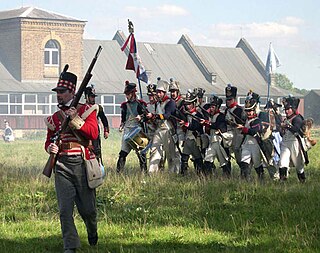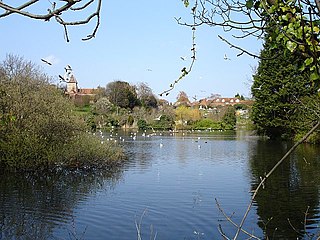
Cordite is a family of smokeless propellants developed and produced in Britain since 1889 to replace black powder as a military firearm propellant. Like modern gunpowder, cordite is classified as a low explosive because of its slow burning rates and consequently low brisance. These produce a subsonic deflagration wave rather than the supersonic detonation wave produced by brisants, or high explosives. The hot gases produced by burning gunpowder or cordite generate sufficient pressure to propel a bullet or shell to its target, but not so quickly as to routinely destroy the barrel of the gun.

Faversham is a market town in Kent, England, 8 miles (13 km) from Sittingbourne, 48 miles (77 km) from London and 10 miles (16 km) from Canterbury, next to the Swale, a strip of sea separating mainland Kent from the Isle of Sheppey in the Thames Estuary. It is close to the A2, which follows an ancient British trackway which was used by the Romans and the Anglo-Saxons, and known as Watling Street. The name is of Old English origin, meaning "the metal-worker's village".

Royal Ordnance Factories (ROFs) were munitions factories run by the UK government during and after the Second World War. The three main types of factories were engineering, filling and explosives, and these were dispersed across the country for security reasons. ROFs were the responsibility of the Ministry of Supply and later the Ministry of Defence until privatisation in 1987.

A filling factory was a manufacturing plant that specialised in filling various munitions, such as bombs, shells, cartridges, pyrotechnics, and screening smokes. In the United Kingdom, during both world wars of the 20th century, the majority of the employees were women.

Kynoch was a manufacturer of ammunition that was later incorporated into ICI, but remained as a brand name for sporting cartridges.

The Royal Gunpowder Mills are a former industrial site in Waltham Abbey, England. It was one of three Royal Gunpowder Mills in the United Kingdom. Waltham Abbey is the only site to have survived virtually intact.

The Davington Light Railway was a narrow gauge railway built to serve the armaments factories near Davington, in Kent, England. It ran between Davington and Uplees.

Oare Marshes is a 71.4-hectare (176-acre) Local Nature Reserve north of Faversham in Kent. It is owned and managed by Kent Wildlife Trust. It is part of The Swale Nature Conservation Review site, Grade I, National Nature Reserve, Ramsar internationally important wetland site, Special Protection Area under the European Union Directive on the Conservation of Wild Birds, and Site of Special Scientific Interest.

Oare is a village and civil parish north of Davington, Faversham in southeast England. It is separated from Faversham by the Oare Creek. To the north of the village are the Oare Marshes, and the Harty Ferry which once linked to Harty on the Isle of Sheppey. Kent Wildlife Trust manages a nature reserve that is an important stopping place for migratory birds.

Davington is a suburb of Faversham, in the Swale district, in the county of Kent, England.

The Ballincollig Royal Gunpowder Mills was one of three Royal gunpowder mills that manufactured gunpowder for the British Government. Located in Ballincollig, Cork city, Ireland, largely in what is now the Ballincollig Regional Park, the powder mills were originally opened in 1794 as a private enterprise, before being taken over by the British Government during the Napoleonic Wars.
Uplees is a remote hamlet north of Faversham, Kent in southeast England. It was a key part of the Faversham explosives industry during World War I, with the Cotton Powder Company importing raw materials via the deepwater channel of the Swale, and the associated Explosives Loading Company exporting completed bombs and shells. Employees came to work from Faversham on the Davington Light Railway of which Uplees was the northern terminus. It is in the civil parish of Oare.
Barwick, Great Barwick, and Little Barwick are hamlets in the civil parish of Standon in Hertfordshire, England. They are near the A10 road and the village of Much Hadham and the hamlet of Latchford. The River Rib flows behind Barwick and through Great Barwick. There is a ford crossing at Great Barwick.

A gunpowder magazine is a magazine (building) designed to store the explosive gunpowder in wooden barrels for safety. Gunpowder, until superseded, was a universal explosive used in the military and for civil engineering: both applications required storage magazines. Most magazines were purely functional and tended to be in remote and secure locations. They are the successor to the earlier powder towers and powder houses.

From 1802 to 1921, Eleutherian Mills was a gunpowder mill site used for the manufacture of explosives founded by Eleuthère Irénée du Pont, which grew into the DuPont company. The name also refers to the house on the hill above the mills, which was the first du Pont family home in America. In 1957 the site became an outdoor museum when the Hagley Museum and Library was founded. The site was declared a National Historic Landmark in 1966.

A powder mill was a mill where gunpowder is made from sulfur, saltpeter and charcoal.

The Small Arms Ammunition Factories (SAAF) were ammunition manufacturing plants run by the Australian government. Nearly all of their production was for domestic use by their military, the police forces, and government-appointed agents.

The Poudrerie nationale de Vonges is a French powder mill established in 1691 in Vonges, Côte-d'Or. It manufactured explosives for use in quarries, mines and fireworks. During World War I (1914–18) it manufactured munitions. It expanded after the war, producing explosives for civil use. During World War II (1939–45) production was scaled back drastically, but expanded again after the war. The powder mill was fully privatized in 2008.

The memorial to the victims of the 1916 Faversham Munitions Explosion is a Grade II* listed building in Love Lane cemetery, in Faversham, Kent. Unveiled in 1917, it incorporates a granite Celtic cross and the granite structures surrounding a mass grave for 73 people killed by the Faversham explosion on 2 April 1916, and a nearby freestanding stone which records the names of another 35 who were buried elsewhere. The memorial became a Grade II listed building in 1989, and was upgraded to Grade II* in March 2016 just before the centenary of the explosion.


























